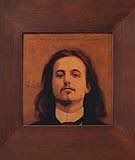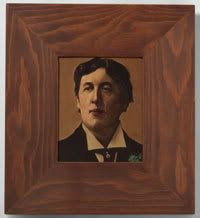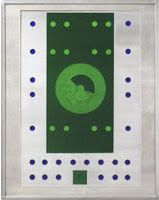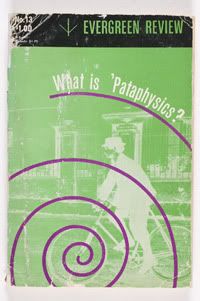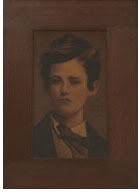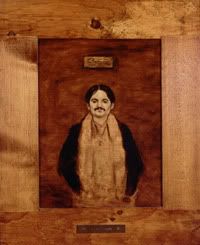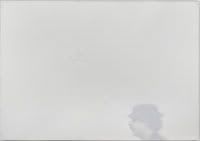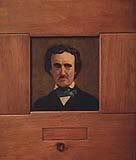About a month ago in the advertising pages at the back of a Friday New York Times Arts Section there was a small image of Alfred Jarry, one of the originators of modern theatre, creator of the absurd tyrant, Ubu, and inventor of ‘Pataphysics,’ a series of speculations and investigations concerning the interrelationship of time, imagination, and perception. The image was based on a widely circulated picture of the playwright in his youth – full face haloed by a shock of shoulder-length hair, chin defiantly set above a high celluloid collar, eyes leveled unsparingly on the viewer – and appeared to be centered in a wide, square frame. Just above the frame’s top left edge in white block letters, stark against the ad’s black background was the name “Thomas Chimes.” It was difficult to pull away from the hypnotic image of Jarry long enough to gather the remaining information from the ad, which indicated that Thomas Chimes was a notable Philadelphia artist currently enjoying a retrospective with the unlikely title of “Adventures in ‘Pataphysics” at the Philadelphia Museum of Art. A nearly imperceptible line of type bordering the right edge of the frame confirmed that the image was a “Portrait of Alfred Jarry” from the Museum’s own collection, but it didn’t offer any indication of media. The portrait appeared to be, by turns, either a painting or a photograph – but despite this, the picture conveyed a surety of intention which was seemingly devoid of irony. In fact, it was nearly impossible to gain any appraising cerebral distance from the image’s cockeyed nobility and allure, which was evident even in this black and white reproduction. Whoever Thomas Chimes was, he’d somehow produced an image that had a startling visual directness, but was not conveniently or conventionally readable – and that in itself was worth a trip to Philadelphia.
A visitor to Thomas Chimes: Adventures in ‘Pataphysics will meet a number of engaging, distinct, but ultimately interlocking incarnations of the artist. The earliest works in the exhibition are paintings from the 50’s and 60’s which resemble an improbable encounter between Marsden Hartley and Matisse. These paintings suddenly give way to the metal box constructions of the 70’s, which are erotic-machine boxes of desire – and suggest an even more improbable meeting of Joseph Cornell and Ernest Trova, the Pop sculptor of sleek, Eros-robots. Installed with the boxes are a number of related drawings and studies, which ultimately have a greater impact than the boxes themselves. The dual engines of eroticism – desire and longing – are forever in a struggle with time and decay, and it is this dialectic made visible which energizes Cornell’s astonishing boxes. Chimes’ boxes are so well-crafted, polished, and literally steely that they appear impervious to age, making them vaults, rather than vessels, of desire and longing.
Two of the last and most satisfying boxes, containing painted portraits of Greta Garbo and John Lennon, respectively, are portals to this retrospective’s most remarkable work – a suite of portraits which form the core of the exhibition. These particular boxes also offer a clue to what makes much of Chimes’ mature imagery so oddly alluring. An eerie dissonance in both the Garbo and Lennon boxes – conveniently installed side-by-side – causes the viewer to revisit the portraits at the heart of these pieces until it sinks in that each portrait appears to be a subtle composite of both Garbo and Lennon – and Chimes (catalogues scattered throughout the exhibition contain numerous photos of Chimes). This subliminal twist is a crucial preparation for the core portrait works.
Central to the core suite is the figure of Alfred Jarry, and ‘Pataphysics – his “science of imaginary solutions,” which amounts to an ever-moving target of vaudeville and alchemy. It’s clear that ‘Pataphysics is a flash-point, and even a devotional impetus for Chimes’ portraits, but it doesn’t get in his way. None of the para-philosophical – and ultimately verbal – material is yoked directly onto the paintings. There is no ponderous scaffolding to delay either the images’ initial visual impact, or their credible presence which invites the viewer to return to them again and again. It is indicative of Chimes’ originality that, contrary to prevailing trends, he decisively sacrifices his philosophical and literary sources in the course of his working process – the way a catalytic agent is often burned off in chemical production – in order to achieve a purely visual elixir.
Chimes has been building this portrait suite since the mid-1970’s, and it is essentially an array of select Modernist pioneers whose inclusion in the series is based upon their having some relationship to Alfred Jarry himself, or to his writings. The suite is divided into two phases – the initial oil on panel works, and the more recent, larger “white” oil paintings on canvas.
In the early, smaller works the rich browns of the prepared, but ungessoed, wood provide a middle ground for the nearly monochromatic images, which are often relieved by flourishes of striking color, such as the Crimson blush on Oscar Wilde’s lips, or Poe’s Viridian necktie. All of the images are derived from relatively familiar photographs of the subjects, but they are in no way Photo-real, nor are they especially painterly – they are, however, hauntingly Other.
Anyone familiar with much of the work lurking in provincial art centers, middle-brow galleries, or art schools knows that painting from photographs is usually a disservice to both painting and photography. The moment the photograph appeared it began to be borrowed, mostly for reasons of naïve wistful-ness or convenience. Sophisticated strategies of appropriation, such as Gerhard Richter’s – where the space between photograph and painting, stability and instability, source and image, subject and intention permits the shadow-fall of doubt and irreconcilability – are rare.
Chimes’ approach to photo derivation, as well as his intention, while 180º of Richter’s, is no less successful or sophisticated. In the space between source and image Chimes perceives a profoundly Romantic opportunity for inhabitation – in the Sturm und Drang way Romantic poets inhabited conditions of weather to convey human mood and drama. In a number of these portraits – Jarry, Poe, Ubu, Wilde, Apollinaire – as in his Garbo and Lennon boxes, Chimes seems to hover within the features of his subjects. In possessing the motivating ideas of his subjects, Chimes the visual artist discerns an opportunity to go further and possess the very image of his sources. This strategy of composite disguise is reminiscent of Marcel Duchamp’s photo-incarnations as Rrose Sélavy, his female alter-ego. Duchamp is admired by Chimes, and also featured (as Rrose Sélavy) in the portrait suite, but there’s none of the Modernist gadfly’s coy irony in these inhabited portraits. Instead, Chimes’ intention is more in keeping with the late-19th Century’s thrall of Séance – and his method is more akin to that of the late poet James Merrill who, with his companion David Jackson, summoned a host of deceased literary figures and other personages via the Ouija board, and composed these encounters into three amazing books of poetry, collectively titled The Changing Light at Sandover. In this portrait group Chimes doesn’t venerate, or even conventionally paint his subjects – he channels them.
This fervor eventually gives way to the more recent “white” paintings, again mainly comprised of portraits of vanguard Modernists – and while Jarry is present in this series, it is the spirit of Erik Satie, the early avant-garde composer and contemporary of Jarry, that pervades this work. Where the earlier portraits were grounded in a Romantic response to the literature of ‘Pataphysics, these “white” portraits have a strong kinship with music, particularly the revolutionary, Modernist music of Satie. Much of Satie’s spare, transfixing music was composed for piano, and essentially creates an effect of notes “dropped” within an aural space where they are suspended until they are displaced by subsequent notes, or simply decay – much in the same way that pebbles, dropped into a still pond, create “reverberating” concentric circles which are gradually absorbed into the pond’s stillness. Likewise, in Chimes’ “white” portraits the faces of his subjects appear as transitory reverberations which are about to be absorbed into the veiled layers of oil paint in which they are suspended – and like Satie’s music, the effect is as mesmerizing as it is original.
By virtue of their contrary temperaments, and the dates they occupy (1866-1925 and 1873-1907, respectively) – both Erik Satie and Alfred Jarry nimbly escaped the crackdown by Modernism’s rationalists, who harnessed Modernity to the cooler spectrum of Enlightenment thought. Nearly a century later, Thomas Chimes finds himself in a visual culture where cunning, reasoned strategies of career and working concepts are frequently rewarded, yet Chimes persists with a detachment that is eccentric, not bloodless. He is possessed by an inquisitive mind which serves, but does not hinder a passionate, visionary eye and heart.
Perhaps the New World’s gift to Modern painting has been eccentricity – as evidenced in the wildly diverse and contrary work of painters such as Frida Kahlo, Philip Guston, Remedios Varo, Agnes Martin, and Albert York. To this litany of mavericks can be added the name of Thomas Chimes, who seems to be maintaining a brilliant resistance of his own in Philadelphia.
